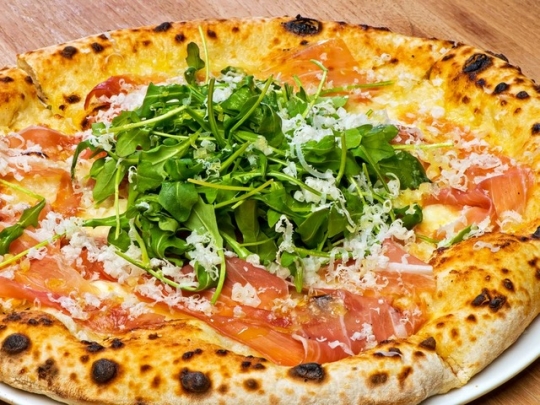Neapolitan pizza, with its soft, melt-in-your-mouth dough and a thick and puffy crust has been prepared in Naples, Italy since the year 1725 as simple and traditional street food. Today, this style of pizza is considered ‘the real deal’.Following Italian migration in the 19th and 20th centuries, pizza has grown to become an international symbol of Italian cuisine, giving life to hundreds of variations around the world.
However, the real Neapolitan pizza remains hard to come by. It needs specific ingredients and preparation skills, all of which result in a unique taste and texture. Neapolitan pizza is so unique that in 2017 it was recognised as a ‘UNESCO Intangible Cultural Heritage’ product and as a Traditional Specialty Guaranteed’ [Specialità Tradizionale Garantita] product in the EU [European Union].
How can you recognise the real deal? Luckily, the Verace Association of Neapolitan Pizza [Associazione Verace Pizza Napoletana] has created a set of guidelines:
The genuine dough consists of wheat flour [type 0 or type 00, or a mixture of both], natural yeast or brewer yeast, salt, and water. Flour with high protein content allows for a fluffy and stretchy dough resulting in an optimal pizza. Traditional Neapolitan dough is recognised for its elasticity, born during the mixing process. Neapolitan pizza makers know the exact sound the dough should make when ready, signalling that it now needs to be left to rest for approximately 36 hours before usage.
The ball of dough is then stretched by hand into the shape of a disk. The ‘pizzaiolo’ uses his hands to work the dough in a circular motion, helping air move from the centre to the edge, resulting in a ready-to-eat pizza with a deliciously thick and puffy crust. A curious method used to stretch the dough is known as the ‘slap’, this is where the disc is slapped between one hand and the other, taking advantage of gravity.
Being an artisanal product, each pizza will be slightly different in shape and size; pizza making is an art and the ‘pizzaiolo’ the artist. To perfectly replicate the dish time and time again using only your hands is impossible.
Considering only the most classic of all Neapolitan pizza; the ‘Margherita’ must be prepared with ingredients grown only in Campania, Italy, if one seeks the original taste.
• Tomatoes grown in the vulcanic plains to the south of ‘Mount Vesuvius’ [Monte Vesuvio]. The best-known varieties are ‘San Marzano dell’Agro Sarnese Nocerino’ and ‘Pomodorino del Piennolo’, both Protected Denomination of Origin [Denominazione di Origine Protetta] products under EU law.
• ‘Mozzarella di Bufala’ [Buffalo Mozzarella produced from Mediterranean Buffalo milk], produced from stock raised in the marshlands of Campania. As an alternative, one could use ‘Fior di Latte’, a Mozzarella produced from cows grazing in the fields around the city of Agerola.
• Fresh Basil leaves always placed on top of all other ingredients.
• Extra Virgin Olive Oil drizzled over everything in a spiralling motion after the pizza is removed from the oven and ready to be eaten.

Neapolitan pizza needs to be baked on the stone base of a wood-fired oven for 90 seconds at 450°C. The oven, traditionally dome-shaped for optimal temperature distribution, should only use wood and please remember that different wood will give it a different aroma.
Neapolitan pizza should be round, with a diameter of less than 35 cm, and no thicker than 4mm at the centre. The crust should be thick, puffy, golden, and with only a few burn bubbles.
The result is a well-painted canvas. The ‘Margherita’, the most classic of all Neapolitan pizza, was created in 1889 by Raffaele Esposito, as a gift to Queen Margherita, the queen of unified Italy, the red of the tomatoes. blends with the white of the mozzarella, and the green of the basil to depict the Italian flag.
When served it should reflect:
• an intense aroma of baked bread
• a fruity fragrance from the oil or the garlic
• a balance of other toppings
It all depends on the toppings chosen, but if properly prepared it will taste intense, but balanced, with a crispy and puffy golden crust surrounding a soft and delicious centre.
Three of the best pizzerias in Italy
Like gelato, not all pizzas taste the same. With that in mind, the editorial Team of IDS has chosen 3 pizzerias in Italy with a proven record of real Neapolitan-style pizza.
These pizzerias are also listed on the ‘Guida Pizzerie d’Italia 2020’ [Guide Pizzerias of Italy 2020], as published by ‘Gambero Rosso’.
Ammaccàmm in Naples
The last born of the ‘Peperino’ group as a testament to the passion for his land that Nicola Taglialatela has always carried with him in his heart.
Le Follie di Romualdo in Florence
Romualdo inaugurates 'Le Follie di Romualdo', in the historic Convivium in Florence and offering a cuisine tied to the Campania tradition but attentive to experimentation and the use of cutting-edge gastronomic techniques.
Montegrigna by Tric Trac in Milan
The ingredients, combined with the wisdom of Bruno who knew them in his childhood in Tramonti on the Amalfi Coast, are continuously sought after.
……………… o ………………
Next time you go to a pizzeria claiming to serve ‘Real Neapolitan Pizza’, remember the above 7 magnificent tell-tale signs, they will help you recognize the real deal.
Remember that your journey of discovery does not end here, stay tuned for the next episode and join the Team from Italian Dining Summit as we show you how to recognise a real 'Risotto'.
I would like to take this opportunity to thank Vegetarian Chef Paolo Baratella and Pizzaiolo Pierluigi Madeo for their valuable technical input, also Carlo Asmar for his editorial assistance in bringing this article to fruition.

